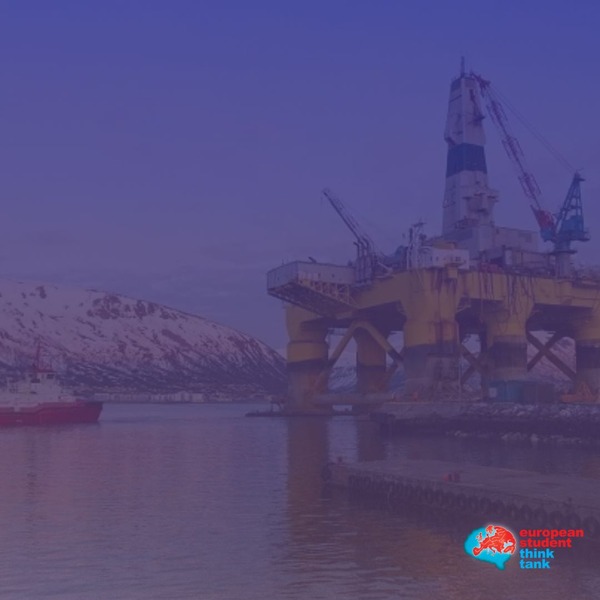
Written by: Aryna Golovach
Edited by: Lucia Duque Teva

Introduction
The presence of natural resources is frequently debated as both a gift and a curse. Poor governance of such resources often leads to the so-called ‘Dutch Disease’ – the decline of other sectors, such as export and manufacturing, in the case of discovery and rapid growth of natural resource extraction (Larsen, 2006, p. 607). Another major concern is the vulnerable nature of ecosystems, as activities like oil production cause several environmental issues, ranging from oil spills to carbon emissions, which exacerbates climate change in the long term. Recent statistics from the International Energy Agency indicate that approximately 15% of the annually produced CO2 emissions are caused by the gas and oil extracting industry (IEA, 2023).
Environmentalism and oil production tend to be contradictory; however, Norway paradoxically manages to find a balance between the two. According to IEA (2022), Norway produces 57.8% of crude oil in Europe. At the same time, it is recognised as one of the most environmentally conscious countries, ranking fifth in the 2025 European Sustainable Development Report (EU Dashboards, 2025). This success is largely due to strict regulation policies, which have been carefully developed and adapted to benefit from oil export while maintaining ecological prosperity.
This article aims to explain Norway’s paradoxical success of natural resource governance, analysing its strategy as well as the lessons that can be learned from that example, to contribute to sustainable development. In the following sections, a brief historical context will be provided as well as an overview of the most efficiently implemented policies – such as carbon taxation, the establishment and investments in the Sovereign Wealth Fund, and the focus on renewable energy.
The Rise of Oil Production in Norway
Before examining specific strategies that have made Norway’s oil industry both profitable and environmentally responsible, it is important to understand the historical context behind it. Norway is considered a relatively new player in the oil-producing industry. Prior to the discovery of the oil fields in the North Sea, the country’s main exports consisted of raw materials and fishery products. Additionally, at that time the shipbuilding sector was thriving in the country, reaching its peak by the late 1960s. Around that time, the U.S. oil company Phillips first suggested the possibility of oil reserves in the North Sea. In response, the Norwegian government declared sovereignty over its underwater territories in 1963, following a similar policy previously adopted by the UK. Following this, Norway engaged in negotiations with neighbouring countries to define sea borders. In 1970, the Ekofisk field was discovered, marking the first large oil find on the Norwegian continental shelf (Ryggvik, 2015).
Remarkably, before it was clear that the amount of fossil fuel situated within the Norwegian Sea border was significant, the government of the Kingdom was hesitant about whether it should take part in the concession rounds (Ryggvik, 2015). Evaluation of the possible economic growth perspectives led Norwegian policymakers to acknowledge the importance of the development of the newly emerged industry. As Larsen notes in his work (2006, pp.618-620), many preventive and regulatory policies regarding natural resources management were formulated in the earliest stage of Norway’s oil production history. Most of them were related to ensuring financial stability and avoiding the Dutch disease, yet some could be indirectly rooted in environmental concerns. Notably, the Spillover-loss Policy and the Education, Research, and Development Policy have contributed to the environmentalist strategies developed in the following decades. Both initiatives emphasise the importance of investment in research, education, and advanced training. The Spillover-loss policy also highlights particularly the importance of national experts over foreign ones (Larsen, 2006).
State Control of the Oil Revenue through The Sovereign Wealth Fund
Norway’s long-term policy approach fostered expertise and research that increased ecological awareness and strengthened hydrocarbon regulations. Another pivotal step towards effective resource governance happened in 1990 with the establishment of the Government Petroleum Fund. Commonly referred to as the Oil Fund and later renamed to the Government Pension Fund, it uses the income from oil production for investment purposes to ensure pensions and other social security benefits for the population, and secure economic stability in case of global oil price fluctuations and crises (Polus & Tycholiz, 2017). According to the Sovereign Wealth Fund Institute (2025), Norway’s Sovereign Wealth Fund is marked as the biggest one in the world, accumulating more than 1,738 trillion US dollars in assets.
To successfully manage such a large-scale capital, the Norwegian Government has developed a set of complex regulatory frameworks. Firstly, the Fund is subdivided into the Government Pension Fund Global (GPFG), managed by Norges Bank Investment Management (NBIM), and the Government Pension Fund Norway (GPFN), overseen by the asset management group Folketrygdfondet. While GPFN has a smaller amount of assets and focuses on investment opportunities within Norway and Scandinavian states, GPFG is open to global actors. Despite the difference in the capital amount and the area of interest, both funds follow the investment mandate set by the Norwegian Finance Ministry (Polus & Tycholiz, 2017). Transparency is a cornerstone of this system, with NBIM regularly publishing reports on investment strategies, risk management, and governance structures accessible to the public.
There is also a section “Responsible investment” giving a detailed overview of the initiatives related to climate change, sustainability, and ethical responsibility. Following these principles, GPFG avoids engagement with companies violating human rights, producing and distributing weapons, tobacco, and engaging in corruption schemes. Additionally, the full list of the eliminated companies is accessible to a wider public. Among the ethical criteria for exclusion, many are also related to eco-violence and environmental damage such as excessive emissions or coal production (Norges Bank Investment Management, 2025). A thoughtful and selective investment model is yet another proof of Norway’s long-term strategic policymaking. By prioritizing ethical investments, Norway reduces dependence on non-renewable energy sources while maintaining public trust and credibility.
Addressing Carbon Emissions
As it was previously mentioned, Carbon Emissions remain one of the key issues linked to the oil production industry. Hence, it is crucial for the countries involved in the industry to address it and develop efficient policies to avoid environmental damage. According to Banet (2017), key regulations implemented by Norway include CO2 taxation and participation in the Emissions Trading Scheme (ETS). Norway, which introduced the CO2 tax in 1991, is among the pioneers of such measures. The variety of taxable activities has expanded, and the tax rate has been growing since the beginning of the initiative. As per Banet (2017), taxation covers around 55% of the total greenhouse emissions in the country. It is important to mention that the CO2 tax is not only related to petroleum as it also covers the usage of mineral oil and fossil fuels in other industries such as heating, manufacturing and fishing. It is worth mentioning that part of the income from the CO2 tax is directed to the Carbon Capture Storage research and advancement. Such measures are necessary to optimise the oil sector and control released emissions (Merritt-Thrasher, 2011).
In addition to national policies, Norway actively participates in international initiatives to prevent climate change and ecology damage. Among such is the previously mentioned ETS developed by the European Union. As a part of the European Economic Area, Norway has joined the initiative that covers sectors producing around 45% of the total CO2 pollution in Europe. As an alternative to the direct carbon tax, ETS sets a limit on total CO2 produced by firms and provides incentives for investing in technological advancements to minimise emissions. Economic incentives can be traded between companies – sold by the companies who were able to reduce their emissions to an amount lower than their predicted maximum (Merritt-Thrasher, 2011). Overall, it is prominent that Norway is addressing the problem on both national and international levels while also investing in infrastructure development. Additionally, following NBIM (2025), the fund is planning to drive its portfolio firms to net zero emissions by 2050 according to the Paris Agreement.
The Green Future
Beyond addressing current issues related to oil production, Norway is also actively transitioning to renewable energy. According to IEA (2022), the country is planning to establish a “low emission society” by 2050 with total emission levels lowered by half in 2030 compared to 1990. As of 2020, 87% of Norway’s natural resources were exported and 92% of electricity in the country was powered by hydropower.
Transportation is another sector where Norway has made significant progress by emphasising electric vehicles. Norway is a leader in EV sales, which is achieved by high subsidies for zero-emission cars combined with high purchase and CO2 taxes on oil-fuelled vehicles (IEA, 2022). Additionally, EV car owners have some other privileges such as access to bus lanes, and lower fares on ferries and tolls. In 2024, 89% of newly sold cars were hybrid or fully electric, prompting the government to set a target of 100% zero-emission car sales by 2025 (Norsk elbilforening, 2025).
Conclusion and Criticism
Norway’s way of natural resource management emphasises the importance of efficient policy making and implementation while serving as a great example of balancing out oil production with environmental responsibility. The key features of Norway’s successful strategy include long-term planning and severe regulations. As is seen in Norway’s history, ever since the discovery of the first oil source, restriction policies have been adopted. This allowed the country to focus on sustainability rather than instant revenue. Moreover, the emphasis on research, local expert education, and technological innovation has contributed to more thoughtful policy decisions. For instance, investments in CCS optimisation have helped minimise emissions, while focusing on alternative energy sources contributes to the development and popularisation of such. The Sovereign Wealth Fund and the transparency of its portfolio have further solidified Norway’s reputation as a leader in responsible resource management. Additionally, fiscal policies such as CO2 taxes encourage accountability for possible ecological risks.
However, Norway’s environmental reputation is not without criticism. The main reason for that is the duality of the country’s actions and policies. On one hand, its strict regulations on the domestic level resulted in a lower CO2 footprint and the growth of the green energy sector. On the other hand, Norway remains one of the largest oil and gas exporters in the world, significantly contributing to global CO2 emissions, especially considering that importing countries frequently do not have as many restricting policies regarding the usage of fossil fuels as Norway. Hence, it might be considered as outsourcing the damage rather than getting rid of it fully. In 2024 the Norwegian youth environmentalist organisation Natur og Ungdom and Greenpeace Nordic sued the Norwegian government in court over the approval of three North Sea oil and gas fields, arguing that their climate impact assessments violate national and EEA climate laws (Greenpeace, 2024).
Despite facing such challenges and contradictions, the case of Norway remains one of the greatest examples of effective resource governance. Yet it also proves that regulating the effects caused by fossil fuel production is not enough and that the reduction of reliance on the oil sector is needed for the transition to a zero-emission society.
Sources
Banet, C. (2017). Effectiveness in Climate Regulation: Simultaneous Application of Carbon Tax and Emissions Trading Scheme to the Offshore Petroleum Sector in Norway. Carbon & Climate Law Review (CCLR), 11(1), 25-38. Retrieved from https://heinonline.org/HOL/P?h=hein.journals/cclr2017&i=31
EU Dashboards. (2025). Retrieved 2025, from eu-dashboards.sdgindex.org: https://eu-dashboards.sdgindex.org/
Godal, O., & Holtsmark, B. (2001). Greenhouse gas taxation and the distribution of costs and benefits: the case of Norway. Energy Policy, 29(8), 653-662. doi:10.1016/S0301-4215(00)00158-0
Greenpeace. (2024, September). Youth and environmentalists in Norway seek to halt production of oil and gas fields on appeal. Retrieved 2025, from greenpeace.org: https://www.greenpeace.org/international/press-release/69503/youth-and-environmentalists-in-norway-seek-to-halt-production-of-oil-and-gas-fields-on-appeal/
IEA. (2022). Europe Oil supply. Retrieved 2025, from iea.org: https://www.iea.org/regions/europe/oil
IEA. (2022). Norway 2022: Executive Summary. Retrieved 2025, from iea.org: https://www.iea.org/reports/norway-2022/executive-summary
IEA. (2023, March 03). Emissions from Oil and Gas Operations in Net Zero Transitions. Retrieved 2025, from iea.org: https://www.iea.org/reports/emissions-from-oil-and-gas-operations-in-net-zero-transitions
Larsen, E. R. (2006). Escaping the Resource Curse and the Dutch Disease? When and Why Norway Caught up with and Forged Ahead of Its Neighbors. The American Journal of Economics and Sociology, 65(3), 605-640. Retrieved from https://www.jstor.org/stable/27739583
Merritt-Thrasher, K. M. (2011). Tracing the Steps of Norway’s Carbon Footprint: Lessons. Indiana International & Comparative Law Review, 21(2), 319-358. Retrieved from https://heinonline.org/HOL/Page?handle=hein.journals/iicl21&id=323&collection=journals&index=
Norges Bank Investment Managment. (2025). Retrieved 2025, from nbim.no: https://www.nbim.no/en/responsible-investment/
Norsk elbilforening. (2025). Norwegian EV policy. Retrieved from elbil.no: https://elbil.no/english/norwegian-ev-policy/
Polus, A., & Tycholiz, W. J. (2017). The Norwegian Model of Oil Extraction and Revenues Management in Uganda. African Studies Review, 60(3), 181-201. Retrieved from https://www.jstor.org/stable/26410176
Ryggvik, H. (2015). A Short History of the Norwegian Oil Industry: From Protected National Champions to Internationally Competitive Multinationals. The Business History Review, 89(1), 3-41. Retrieved from https://www.jstor.org/stable/43897504
SWFI. (2025). Retrieved 2025, from swfinstitute.org: https://www.swfinstitute.org/fund-rankings/sovereign-wealth-fund

 The ’Ndrangheta’s Infiltration and Threat to European Institutions
The ’Ndrangheta’s Infiltration and Threat to European Institutions  From Paper to Practice: How Grassroots Norms Undermine Gender Rights in Pakistan
From Paper to Practice: How Grassroots Norms Undermine Gender Rights in Pakistan  Exploited Childhoods: The Role of Global Corporations in Perpetuating and Mitigating Child Labour
Exploited Childhoods: The Role of Global Corporations in Perpetuating and Mitigating Child Labour  Human Rights Challenges in Addressing SLAPPs in Media, NGOs and Journalism in the EU
Human Rights Challenges in Addressing SLAPPs in Media, NGOs and Journalism in the EU 


